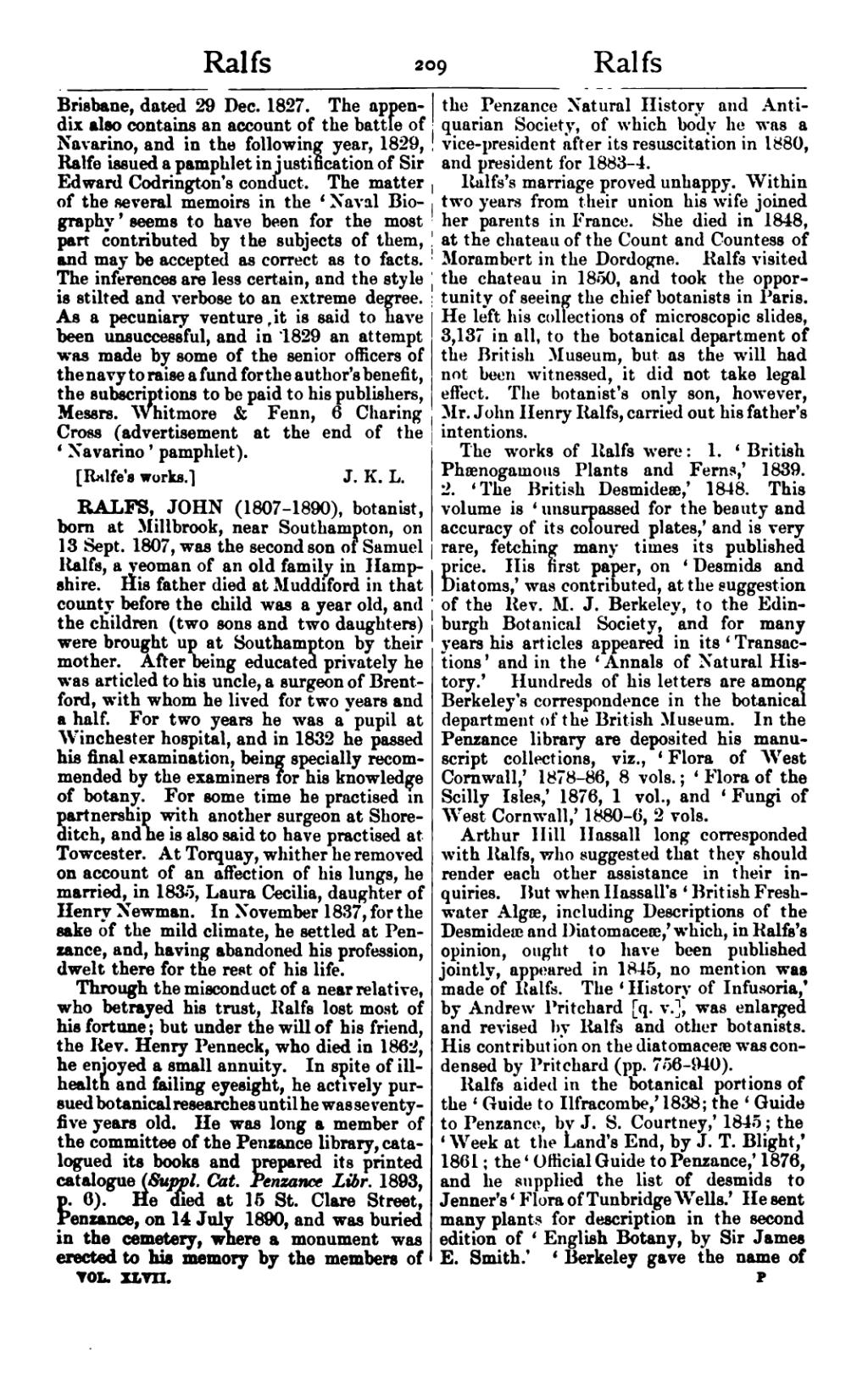Brisbane, dated 29 Dec. 1827. The appendix also contains an account of the battle of Navarino, and in the following year, 1829, Ralfe issued a pamphlet in justification of Sir Edward Codrington's conduct. The matter of the several memoirs in the ‘Naval Biography’ seems to have been for the most part contributed by the subjects of them, and may be accepted as correct as to facts. The inferences are less certain, and the style is stilted and verbose to an extreme degree. As a pecuniary venture it is said to have been unsuccessful, and in 1829 an attempt was made by some of the senior officers of the navy to raise a fund for the author's benefit, the subscriptions to be paid to his publishers, Messrs. Whitmore & Fenn, 6 Charing Cross (advertisement at the end of the ‘Navarino’ pamphlet).
[Ralfe's works.]
RALFS, JOHN (1807–1890), botanist, born at Millbrook, near Southampton, on 13 Sept. 1807, was the second son of Samuel Ralfs, a yeoman of an old family in Hampshire. His father died at Muddiford in that county before the child was a year old, and the children (two sons and two daughters) were brought up at Southampton by their mother. After being educated privately he was articled to his uncle, a surgeon of Brentford, with whom he lived for two years and a half. For two years he was a pupil at Winchester hospital, and in 1832 he passed his final examination, being specially recommended by the examiners for his knowledge of botany. For some time he practised in partnership with another surgeon at Shoreditch, and he is also said to have practised at Towcester. At Torquay, whither he removed on account of an affection of his lungs, he married, in 1835, Laura Cecilia, daughter of Henry Newman. In November 1837, for the sake of the mild climate, he settled at Penzance, and, having abandoned his profession, dwelt there for the rest of his life.
Through the misconduct of a near relative, who betrayed his trust, Ralfs lost most of his fortune; but under the will of his friend, the Rev. Henry Penneck, who died in 1862, he enjoyed a small annuity. In spite of ill-health and failing eyesight, he actively pursued botanical researches until he was seventy-five years old. He was long a member of the committee of the Penzance library, catalogued its books and prepared its printed catalogue (Suppl. Cat. Penzance Libr. 1893, p. 6). He died at 15 St. Clare Street, Penzance, on 14 July 1890, and was buried in the cemetery, where a monument was erected to his memory by the members of the Penzance Natural History and Antiquarian Society, of which body he was a vice-president after its resuscitation in 1880, and president for 1883–4.
Ralfs's marriage proved unhappy. Within two years from their union his wife joined her parents in France. She died in 1848, at the chateau of the Count and Countess of Morambert in the Dordogne. Ralfs visited the chateau in 1850, and took the opportunity of seeing the chief botanists in Paris. He left his collections of microscopic slides, 3,137 in all, to the botanical department of the British Museum, but as the will had not been witnessed, it did not take legal effect. The botanist's only son, however, Mr. John Henry Ralfs, carried out his father's intentions.
The works of Ralfs were: 1. ‘British Phænogamous Plants and Ferns,’ 1839. 2. ‘The British Desmideæ,’ 1848. This volume is ‘unsurpassed for the beauty and accuracy of its coloured plates,’ and is very rare, fetching many times its published price. His first paper, on ‘Desmids and Diatoms,’ was contributed, at the suggestion of the Rev. M. J. Berkeley, to the Edinburgh Botanical Society, and for many years his articles appeared in its ‘Transactions’ and in the ‘Annals of Natural History.’ Hundreds of his letters are among Berkeley's correspondence in the botanical department of the British Museum. In the Penzance library are deposited his manuscript collections, viz., ‘Flora of West Cornwall,’ 1878–86, 8 vols.; ‘Flora of the Scilly Isles,’ 1876, 1 vol., and ‘Fungi of West Cornwall,’ 1880–6, 2 vols.
Arthur Hill Hassall long corresponded with Ralfs, who suggested that they should render each other assistance in their inquiries. But when Hassall's ‘British Freshwater Algæ, including Descriptions of the Desmideæ and Diatomaceæ,’ which, in Ralfs's opinion, ought to have been published jointly, appeared in 1845, no mention was made of Ralfs. The ‘History of Infusoria,’ by Andrew Pritchard [q. v.], was enlarged and revised by Ralfs and other botanists. His contribution on the diatomaceæ was condensed by Pritchard (pp. 756–940).
Ralfs aided in the botanical portions of the ‘Guide to Ilfracombe,’ 1838; the ‘Guide to Penzance, by J. S. Courtney,’ 1845; the ‘Week at the Land's End, by J. T. Blight,’ 1861; the ‘Official Guide to Penzance,’ 1876, and he supplied the list of desmids to Jenner's ‘Flora of Tunbridge Wells.’ He sent many plants for description in the second edition of ‘English Botany, by Sir James E. Smith.’ ‘Berkeley gave the name of
